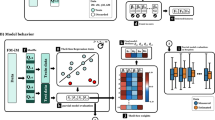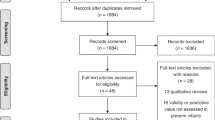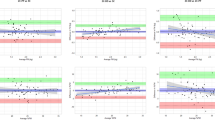Abstract
Background/Objectives:
Assessment of infant body composition (BC) is crucial to understand the consequences of suboptimal nutritional status and postnatal growth, and the effects of public health interventions. Bioelectrical impedance analysis (BIA) is a feasible, relatively inexpensive and noninvasive method for assessing BC. However, very little research has been conducted in low- and middle-income populations, where efforts to prevent or treat malnutrition in early life are a public health priority. We aimed to develop equations for predicting fat-free mass (FFM) and fat mass (FM) based on BIA in 0- to 6-month-old Ethiopian infants.
Subjects/Methods:
The study comprised a total of 186 BC assessments performed in 101 healthy infants, delivered at Jimma University Specialized Hospital. Infant air-displacement plethysmography (IADP) was the criterion method, whereas weight, length, sex, age and an impedance index (L2/Z50) were predictors. Prediction equations were developed using stepwise multiple linear regression and the accuracy was evaluated with a 10-fold cross-validation approach.
Results:
A linear regression model based on body weight, age and sex predicted FFM, estimated by IADP, with an adjusted R2 and root mean square error (RMSE) of 0.94 and 200 g, respectively. Adding impedance index to the model resulted in a significantly improved model fit (R2=0.95; RMSE=181 g). For infants below 3 months of age, inclusion of impedance index did not contribute to an improved model fit for predicting FFM compared with a model already comprising weight, sex and age.
Conclusions:
The derived equations predicted FFM with acceptable accuracy and may be used in future field surveys, epidemiological studies and clinical trials conducted in similar sub-Saharan African population groups aged 0–6 months.
This is a preview of subscription content, access via your institution
Access options
Subscribe to this journal
Receive 12 print issues and online access
$259.00 per year
only $21.58 per issue
Buy this article
- Purchase on Springer Link
- Instant access to full article PDF
Prices may be subject to local taxes which are calculated during checkout



Similar content being viewed by others
References
Wells JCK . Obesity as malnutrition: The role of capitalism in the obesity global epidemic. Am J Hum Biol 2012; 24: 261–276.
Black RE, Victora CG, Walker SP, Bhutta ZA, Christian P, de Onis M et al. Maternal and child undernutrition and overweight in low-income and middle-income countries. Lancet 2013; 382: 427–451.
Popkin BM, Adair LS, Ng SW . Global nutrition transition and the pandemic of obesity in developing countries. Nutr rev 2012; 70: 3–21.
Wells JCK, Fewtrell MS . Measuring body composition. Arch Dis Child 2006; 91: 612–617.
Pietrobelli A, Andreoli A, Cervelli V, Carbonelli MG, Peroni DG, De Lorenzo A . Predicting fat-free mass in children using bioimpedance analysis. Acta Diabetol 2003; 40: 212–215.
Wells JCK . Body composition in infants: evidence for developmental programming and techniques for measurement. Rev Endocr Metab Disord 2012; 13: 93–101.
World Health Organisation Physical Status: The Use and Interpretation of Anthropometry. Report of a WHO Expert Committee. WHO Technical Report Series 854. WHO: Geneva, Switzerland, 1995.
Wells JCK, Fewtrell MS . Is body composition important for paediatricians? Arch Dis Child 2008; 93: 168–172.
Ellis KJ, Yao M, Shypailo RJ, Urlando A, Wong WW, Heird WC . Body-composition assessment in infancy: air-displacement plethysmography compared with a reference 4-compartment model. Am J Clin Nutr 2007; 85: 90–95.
Ma G, Yao M, Liu Y, Lin A, Zou H, Urlando A et al. Validation of a new pediatric air-displacement plethysmograph for assessing body composition in infants. Am J Clin Nutr 2004; 79: 653–660.
Wells JCK, Fuller NJ, Dewit O, Fewtrell MS, Elia M, Cole TJ . Four-component model of body composition in children: density and hydration of fat-free mass and comparison with simpler models. Am J Clin Nutr 1999; 69: 904–912.
Eriksson B, Löf M, Forsum E . Body composition in full-term healthy infants measured with air displacement plethysmography at 1 and 12 weeks of age. Acta Paediatr 2010; 99: 563–568.
Andersen GS, Girma T, Wells JC, Kæstel P, Leventi M, Hother AL et al. Body composition from birth to 6 mo of age in Ethiopian infants: reference data obtained by air-displacement plethysmography. Am J Clin Nutr 2013; 98: 885–894.
Böhm A, Heitmann BL . The use of bioelectrical impedance analysis for body composition in epidemiological studies. Eur J Clin Nutr 2013; 67: 79–85.
Nielsen BM, Dencker M, Ward L, Linden C, Thorsson O, Karlsson MK et al. Prediction of fat-free body mass from bioelectrical impedance among 9- to 11-year-old Swedish children. Diabetes Obes Metab 2007; 9: 521–539.
Clasey JL, Bradley KD, Bradley JW, Long DE, Griffith JR . A new BIA equation estimating the body composition of young children. Obesity 2011; 19: 1813–1817.
Sun SS, Chumlea WC, Heymsfield SB, Lukaski HC, Schoeller D, Friedl K et al. Development of bioelectrical impedance analysis prediction equations for body composition with the use of a multicomponent model for use in epidemiologic surveys. Am J Clin Nutr 2003; 77: 331–340.
Dehghan M, Merchant AT . Is bioelectrical impedance accurate for use in large epidemiological studies? Nutr J 2008; 7: 1–7.
Deurenberg P, Deurenberg-Yap M . Validity of body composition methods across ethnic population groups. Acta Diabetol 2003; 40: 246–249.
Wells JCK, Hawton K, Darch T, Lunn PG . Body composition by 2H dilution in Gambian infants: comparison with UK infants and evaluation of simple prediction methods. Br J Nutr 2009; 102: 1776–1782.
Andersen GS, Girma T, Wells JCK, Kæstel P, Michaelsen KF, Friis H . Fat and fat-free mass at birth: air displacement plethysmography measurements on 350 Ethiopian newborns. Pediatr Res 2011; 70: 501–506.
Urlando A, Dempster P, Aitkens S . A new air displacement plethysmograph for the measurement of body composition in infants. Pediatr Res 2003; 53: 486–492.
Weststrate JA, Deurenberg P . Body composition in children: proposal for a method for calculating body fat percentage from total body density or skinfold-thickness measurements. Am J Clin Nutr 1989; 50: 1104–1115.
Fomon SJ, Haschke F, Ziegler EE, Nelson SE . Body composition of reference children from birth to age 10 years. Am J Clin Nutr 1982; 35: 1169–1175.
Kushner RF, Schoeller DA, Fjeld CR, Danford L . Is the impedance index (ht2/R) significant in predicting total body water? Am J Clin Nutr 1992; 56: 835–839.
Montagnese C, Williams JE, Haroun D, Siervo M, Fewtrell MS, Wells JCK . Is a single bioelectrical impedance equation valid for children of wide ranges of age, pubertal status and nutritional status? Evidence from the 4-component model. Eur J Clin Nutr 2013; 67: 34–39.
Guo SM, Roche AF, Houtkooper L . Fat-free mass in children and young adults predicted from bioelectric impedance and anthropometric variables. Am J Clin Nutr 1989; 50: 435–443.
Houtkooper LB, Lohman TG, Going SB, Howell WH . Why bioelectrical impedance analysis should be used for estimating adiposity. Am J Clin Nutr 1996; 64: 436–448.
Lingwood BE, Coghlan JP, Ward LC, Charles BG, Colditz PB . Measurement of extracellular fluid volume in the neonate using multiple frequency bio-impedance analysis. Physiol Meas 2000; 21: 251–262.
Hastie T, Tibshirani R, Friedman J . Model assessment and selection. In: Hastie T, Tibshirani R, Friedman J (eds). The Elements of Statistical Learning: Data mining, Inference and Prediction, 2nd edn. Springer: New York, NY, USA, 2008, pp 219–260.
Bland JM, Altman DG . Measuring agreement in method comparison studies. Stat Methods Med Res 1999; 8: 135–160.
Lingwood BE, Storm van Leeuwen A-M, Carberry AE, Fitzgerald EC, Callaway LK, Colditz PB et al. Prediction of fat-free mass and percentage of body fat in neonates using bioelectrical impedance analysis and anthropometric measures: validation against the PEA POD. Br J Nutr 2012; 107: 1545–1552.
Dung NQ, Fusch G, Armbrust S, Jochum F, Fusch C . Body composition of preterm infants measured during the first months of life: bioelectrical impedance provides insignificant additional information compared to anthropometry alone. Eur J Pediatr 2007; 166: 215–222.
Ejlerskov KT, Jensen SM, Christensen LB, Ritz C, Michaelsen KF, Mølgaard C . Prediction of fat-free body mass from bioelectrical impedance and anthropometry among 3-year-old children using DXA. Sci Rep 2014; 4: 1–6.
Nightingale CM, Rudnicka AR, Owen CG, Donin AS, Newton SL, Furness CA et al. Are ethnic and gender specific equations needed to derive fat free mass from bioelectrical impedance in children of South Asian, Black African-Caribbean and White European Origin? Results of the assessment of body composition in children study. PLoS One 2013; 8: 1–11.
Haroun D, Taylor SJC, Viner RM, Hayward RS, Darch TS, Eaton S et al. Validation of bioelectrical impedance analysis in adolescents across different ethnic groups. Obesity 2010; 18: 1252–1259.
Heyward VH, Wagner DR . Bioelectrical impedance analysis method. In: Heyward VH, Wagner DR (eds). Applied Body Composition Assessment, 2nd edn. Human Kinetics: Champaign, IL, USA, 2004, pp 87–99.
Ellis KJ, Shypailo RJ, Wong WW . Measurement of body water by multifrequency bioelectrical impedance spectroscopy in a multiethnic pediatric population. Am J Clin Nutr 1999; 70: 847–853.
Sesmero MÁ, Mazariegos M, Pedrón C, Jones J, Solomons NW . Bioimpedance electrical spectroscopy in the first six months of life: some methodologic considerations. Nutrition 2005; 21: 567–573.
Fomon SJ, Nelson SE . Body composition of the male and female reference infants. Annu Rev Nutr 2002; 22: 1–17.
Acknowledgements
We thank Jimma University and University of Copenhagen Alliance on Nutrition (JUCAN), Jimma, Ethiopia for making this study possible. Moreover, we gratefully acknowledge the mothers and their babies for their participation, and the research staff at JUCAN for their dedication to the study. RW was supported by a scholarship from the Lundbeck Foundation and Danida. DLC is supported by the Novo Nordisk Foundation (Grant No. 29847).
Author information
Authors and Affiliations
Corresponding author
Ethics declarations
Competing interests
The authors declare no conflict of interest.
Rights and permissions
About this article
Cite this article
Wibæk, R., Kæstel, P., Skov, S. et al. Calibration of bioelectrical impedance analysis for body composition assessment in Ethiopian infants using air-displacement plethysmography. Eur J Clin Nutr 69, 1099–1104 (2015). https://doi.org/10.1038/ejcn.2015.51
Received:
Revised:
Accepted:
Published:
Issue Date:
DOI: https://doi.org/10.1038/ejcn.2015.51
This article is cited by
-
Dysglycemia associations with adipose tissue among HIV-infected patients after 2 years of antiretroviral therapy in Mwanza: a follow-up cross-sectional study
BMC Infectious Diseases (2017)
-
Risk factors for mortality among malnourished HIV-infected adults eligible for antiretroviral therapy
BMC Infectious Diseases (2016)
-
New cutoff values for fat mass index, fat-free mass index and percent body fat in overweight and obese men living in Riyadh, SA
International Journal of Diabetes in Developing Countries (2016)



